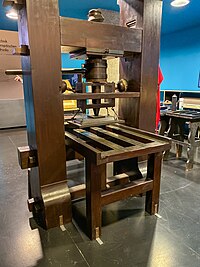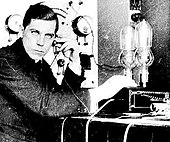
A patent is a type of intellectual property that gives its owner the legal right to exclude others from making, using, or selling an invention for a limited period of time in exchange for publishing an enabling disclosure of the invention. In most countries, patent rights fall under private law and the patent holder must sue someone infringing the patent in order to enforce their rights.
Creative problem-solving (CPS) is the mental process of searching for an original and previously unknown solution to a problem. To qualify, the solution must be novel and reached independently. The creative problem-solving process was originally developed by Alex Osborn and Sid Parnes. Creative problem solving (CPS) is a way of using creativity to develop new ideas and solutions to problems. The process is based on separating divergent and convergent thinking styles, so that one can focus their mind on creating at the first stage, and then evaluating at the second stage.
Jerome "Jerry" Hal Lemelson was an American engineer, inventor, and patent holder. Several of his inventions telate to warehouses, industrial robots, cordless telephones, fax machines, videocassette recorders, camcorders, and the magnetic tape drive. Lemelson's 605 patents made him one of the most prolific inventors in American history.
A person having ordinary skill in the art, a person of (ordinary) skill in the art, a person skilled in the art, a skilled addressee or simply a skilled person is a legal fiction found in many patent laws throughout the world. This hypothetical person is considered to have the normal skills and knowledge in a particular technical field, without being a genius. This measure mainly serves as a reference for determining, or at least evaluating, whether an invention is non-obvious or not, or involves an inventive step or not. If it would have been obvious for this fictional person to come up with the invention while starting from the prior art, then the particular invention is considered not patentable.
Within the context of a national or multilateral body of law, an invention is patentable if it meets the relevant legal conditions to be granted a patent. By extension, patentability also refers to the substantive conditions that must be met for a patent to be held valid.
The inventive step and non-obviousness reflect a general patentability requirement present in most patent laws, according to which an invention should be sufficiently inventive—i.e., non-obvious—in order to be patented. In other words, "[the] nonobviousness principle asks whether the invention is an adequate distance beyond or above the state of the art".
First to file and first to invent are legal concepts that define who has the right to the grant of a patent for an invention. Since 16 March 2013, after the USA abandoned its "first to invent/document" system, all countries have operated under the "first-to-file" patent priority requirement.
Business method patents are a class of patents which disclose and claim new methods of doing business. This includes new types of e-commerce, insurance, banking and tax compliance etc. Business method patents are a relatively new species of patent and there have been several reviews investigating the appropriateness of patenting business methods. Nonetheless, they have become important assets for both independent inventors and major corporations.
Sufficiency of disclosure or enablement is a patent law requirement that a patent application disclose a claimed invention in sufficient detail so that the person skilled in the art could carry out that claimed invention. The requirement is fundamental to patent law: a monopoly is granted for a given period of time in exchange for a disclosure to the public how to make or practice the invention.
The United States is considered to have the most favorable legal regime for inventors and patent owners in the world. Under United States law, a patent is a right granted to the inventor of a (1) process, machine, article of manufacture, or composition of matter, (2) that is new, useful, and non-obvious. A patent is the right to exclude others, for a limited time from profiting from a patented technology without the consent of the patent holder. Specifically, it is the right to exclude others from: making, using, selling, offering for sale, importing, inducing others to infringe, applying for an FDA approval, and/or offering a product specially adapted for practice of the patent.
In patent law, an inventor is the person, or persons in United States patent law, who contribute to the claims of a patentable invention. In some patent law frameworks, however, such as in the European Patent Convention (EPC) and its case law, no explicit, accurate definition of who exactly is an inventor is provided. The definition may slightly vary from one European country to another. Inventorship is generally not considered to be a patentability criterion under European patent law.
Parker v. Flook, 437 U.S. 584 (1978), was a 1978 United States Supreme Court decision that ruled that an invention that departs from the prior art only in its use of a mathematical algorithm is patent eligible only if there is some other "inventive concept in its application." The algorithm itself must be considered as if it were part of the prior art, and the claim must be considered as a whole. The exact quotation from the majority opinion is: "Respondent’s process is unpatentable under §101, not because it contains a mathematical algorithm as one component, but because once that algorithm is assumed to be within the prior art, the application, considered as a whole, contains no patentable invention." "The fact that the algorithm may not have actually been known previously and that, when taken in combination with other claim elements, it might produce an invention that is novel and nonobvious, plays no part in the analysis."
This is a list of legal terms relating to patents and patent law. A patent is not a right to practice or use the invention claimed therein, but a territorial right to exclude others from commercially exploiting the invention, granted to an inventor or their successor in rights in exchange to a public disclosure of the invention.
Title 35 of the United States Code is a title of United States Code regarding patent law. The sections of Title 35 govern all aspects of patent law in the United States. There are currently 37 chapters, which include 376 sections, in Title 35.

Canadian patent law is the legal system regulating the granting of patents for inventions within Canada, and the enforcement of these rights in Canada.
The South African patent system is the system by which patents are granted in South Africa.
Le Roy v. Tatham, 55 U.S. 156 (1852), is a decision of the United States Supreme Court holding that "a newly discovered principle" cannot be patented, and no one can claim in it an exclusive right. This case is considered sometimes as the earliest example of patentable subject matter controversy in the US patent law. This controversy was finally rectified in the 2012 Mayo decision, that requires for a claim, comprising a "natural principle or a law of Nature" to have an additional "inventive concept", which limits the application of the principle to a particular use.
Ariosa Diagnostics, Inc. v. Sequenom, Inc., 788 F.3d 1371, is a controversial decision of the Federal Circuit in which the court applied the Mayo v. Prometheus test to invalidate as patent-ineligible a patent said to "solve ... a very practical problem accessing fetal DNA without creating a major health risk for the unborn child." The rationale for denying patent-eligibility in this case allegedly stems from claims being directed toward non-eligible subject matter , "if the APPLICATION [of this discovery] merely relies upon elements already known in the art."
In US patent law, non-obviousness is one of the requirements that an invention must meet to qualify for patentability, codified as a part of Patent Act of 1952 as 35 U.S.C. §103. An invention is not obvious if a "person having ordinary skill in the art" (PHOSITA) would not know how to solve the problem at which the invention is directed by using exactly the same mechanism. Since the PHOSITA standard turned to be too ambiguous in practice, the U.S. Supreme Court provided later two more useful approaches which currently control the practical analysis of non-obviousness by patent examiners and courts: Graham et al. v. John Deere Co. of Kansas City et al., 383 U.S. 1 (1966) gives guidelines of what is "non-obvious", and KSR v. Teleflex (2006) gives guidelines of what is "obvious".

Patentable subject matter in the United States is governed by 35 U.S.C. 101. The current patentable subject matter practice in the U.S. is very different from the corresponding practices by WIPO/Patent Cooperation Treaty and by the European Patent Office, and it is considered to be broader in general.











